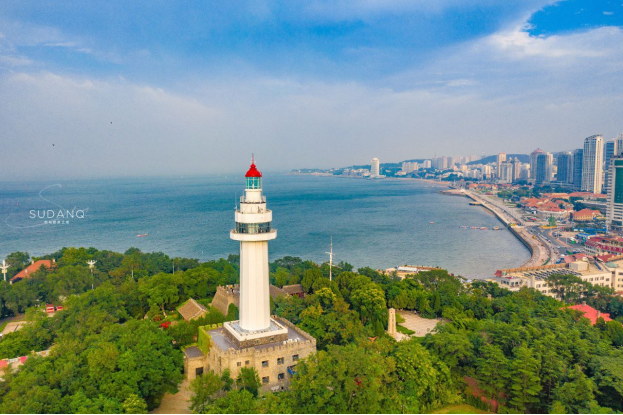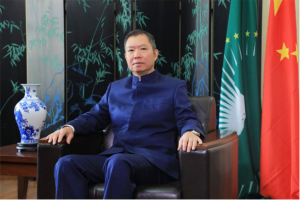
Yantai Mountain is a landmark scenic spot in Yantai city located at the northern end of the city surrounded by the sea on three sides with lush trees and beautiful scenery. Yantai’s scenery is beautiful, and the beauty lies in its Mother Mountain. One cannot only enjoy the beautiful mountains and seas of Yantai, but also learn about the century-old history hidden in Yantai Mountain.
Yantai, located at the northeast end of the Jiaodong Peninsula, is a gateway guarding Beijing and Tianjin, and an important natural harbor in northern China.
Yantai Mountain carved on the stone were personally inscribed by Mr. Wu Zhongqi, a famous calligrapher in China and former chairman of the Jiangsu Calligraphers Association in 2003 at the age of 96. The highest altitude is 42.5 meters, with a total area of about 45 hectares. It is a national key cultural relic protection unit, a national level tourist attraction, a national level marine park, and a provincial-level patriotic education base.
After the opening of Yantai as a commercial port in 1861, 16 countries successively established consulates around Yantai Mountain and its surroundings.
Until today, there are still the former consulates of six countries including the United Kingdom, France, the United States, Germany, Denmark, and Japan, as well as more than 30 office annex buildings on Yantai Mountain, making it the only and most intact and densely concentrated group of modern foreign consulates in Asia. In 2006, it was announced by the State Council as a national protected unit.
At the same time, on the mountain, one can also see folk buildings such as the Martyrs’ Shrine, Beacon Tower, Dragon King Temple, and enjoy the unique natural scenery by the seaside.
Yantai Port-opening Exhibition Hall
There are two buildings in total. The overall building has a brick-wood structure. It is a two-story building above the ground on a square platform, with external corridors on both the east and west sides. It has a four-slope roof with an attic. The exterior wall is a fair-faced wall, and the milky-white windows make it look elegant and refreshing.
In 1941, the Pacific War broke out and the US Consulate was sealed up by the invading Japanese army in Yantai. Today, it is open to the public as the Yantai Port-opening Exhibition Hall mainly focusing on the specific historical time of Yantai’s port opening. It is divided into four parts, eight exhibition halls, with more than 200 exhibits such as pictures and real objects.
Before the Opium War, Yantai already had prosperous commerce, shipping, handicraft industry, and fishery. Due to the corruption of the Qing government and the coercion of foreign powers, humiliating and unequal treaties were successively signed.
In 1858, the Qing government signed the Treaty of Tianjin with Britain and France designating Dengzhou (now Penglai) as a trading port. In 1861, a representative dispatched by the British Minister to China came to Shandong for an inspection.
He believed that the trading conditions in Yantai were superior to those in Dengzhou, so the trading port was changed to Yantai. Subsequently, the Minister of Commerce of the three ports sent officials to Yantai to announce the opening of the port and tax collection.
In 1862, Daotai (local official) of Denglaiqing Circuit concurrently served as the supervisor of East Customs. In 1863, a British person was appointed as the Commissioner of the Donghai Customs. The building in front of the former residence of the Deputy Commissioner of Donghai Customs was built in the late 19th century and features a “veranda style” design.
It was originally the residence of the Deputy Director of Customs and is now open to the public as a national treasure – “Peking Opera” art museum. Above the entrance, one will notice a plaque inscribed with “Yantai Peking Opera Art Museum” in Chinese calligraphy, personally inscribed by former Premier of the State Council Zhu Rongji.
Premier Zhu rarely inscribed characters in his life, so this is also extremely precious for Yantai Mountain.
When it comes to Peking Opera, its earliest origin can be traced back to the Qianlong period. On the 80th birthday of Emperor Qianlong of the Qing Dynasty, the Four Great Anhui Troupes came to Beijing to celebrate the emperor’s birthday. Captivated by the capital’s prosperity, they decided to stay in Beijing.
Over time, these troupes integrated diverse theatrical elements, eventually forming a new genre known as Peking Opera. The term “Peking Opera” first appeared in the Shen Bao newspaper in 1912.
Tianjin and Beijing are respectively the cradle and the main port of Peking Opera, with Yantai playing a crucial role. As a historic maritime hub and one of the earliest treaty ports in northern China, Yantai became a crucial stopover for renowned performers traveling by sea to Beijing and Tianjin.
During layovers, artists would stage impromptu performances there. They soon discovered that Yantai audiences not only adored Peking Opera but also possessed a deep understanding of its nuances.
This led to a tradition of celebrated artists performing in Yantai to test their works. A popular saying at the time went: “To gauge whether a performance will succeed in Beijing, first stage it in Yantai—if Yantai audiences approve, it will thrive.”
The exhibition hall introduced the life profiles of famous actors as well as the origin, development, and expressive techniques of Peking Opera, through various forms such as photos, images, texts, and props.
Beijing Opera began to spread in Jiaodong since it was introduced into Yantai in the second year of Xianfeng of the Qing Dynasty (1852). In 1861, according to the Sino British Treaty on Tianjian, Yantai opened its port and became an important trade port in the north.
In the sixth year of Tongzhi (1867), Beijing Opera began to be introduced into Shanghai from Tianjin. Since then, famous actors from Beijing and Tianjin had flocked to Shanghai to perform.
Yantai, as the only sea route from Beijing and Tianjin to Shanghai, ships often stopped and landed here to avoid wind and waves, commonly known as “ gua kou zi”, stopping for a while. Actors took the opportunity to go ashore to perform and earn money.
Yantai has become a place where “Passing troupes” must stop and perform and had gradually become a nationally famous Beijing opera broadcasting place. Since then it has opened the prelude to the hundred years of the glorious history of Yantai Beijing opera.
BY ADDISALEM MULAT
THE ETHIOPIAN HERALD FRIDAY 2 MAY 2025





